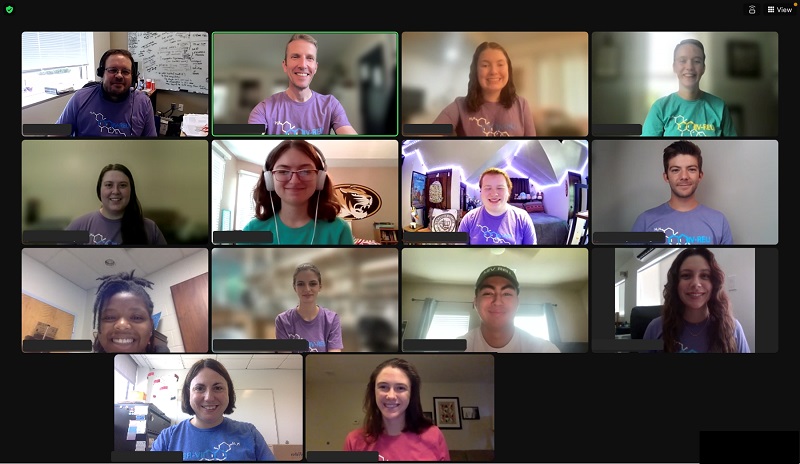News Detail
09/01/2023

Katherine Hicks, a SUNY Cortland associate professor of chemistry, spent the summer doing groundbreaking work with 12 students from across the U.S.
She’s only met one of them in person. And neither she nor her students handled any actual chemicals.
SUNY Cortland is part of a federally funded summer research initiative helping students move the field of chemistry forward without stepping into a traditional laboratory.
The program is the first completely virtual chemistry project to receive a National Science Foundation (NSF) undergraduate research grant. The $345,744, three-year award is shared among SUNY Cortland, Ithaca College and the University of Minnesota.
The students used computer models to determine possible interactions between unique proteins and other molecules. Specifically, they built on existing information about several proteins’ structure and likely functions and explored what molecules were most likely to either enable or impede what each protein does.
“This program helped me to grow in my ability to think independently as a scientist and apply what I have learned from my independent research at SUNY Cortland as well as all of my classes,” said senior biochemistry major Zachary Turlington, the only Cortland student participating this summer. “With all the advancements in technology, the ability to do computational work is now more important than ever.”
Traditionally, this type of examination is done through what Hicks calls “wet work”; old fashioned trial-and-error chemical experiments in a laboratory. Wet work will eventually still need to be done. But the students this summer determined the most likely interactions with several targeted proteins, significantly narrowing the field of real-life chemical tests that need to be done, saving both time and money.
“We picked a class of proteins that haven’t been as well studied in the literature to try to figure out exactly what they do,” Hicks said. “My colleagues on this grant and I are interested in what they call protein structure function. How does knowing the shape, the structure of a protein impact what biological function it has?”
Picture the spike proteins that allowed the coronavirus to penetrate human cells and cause infection. In this case, however, the students are studying bacterial proteins. The NSF supports fundamental research intended to advance general scientific knowledge, so the students weren’t looking for anything specific. like a way to deactivate a protein that causes infection.
Cortland’s online chemistry research program was created during the lockdowns of the global COVID-19 pandemic. Knowing the value of undergraduate research experiences, Hicks, Jarrod French of the Hormel Institute at the University of Minnesota and Andrew Torelli of Ithaca College, initially secured a partial NSF grant to do a summer pilot program in 2021 that would allow students to do genuine chemistry research without physically accessing a laboratory.
Based on the pilot’s success, the NSF gave the team a three-year award, starting in 2022. They discovered that student interest in doing virtual research over the summer doesn’t depend on pandemic lockdowns.
The program requires student researchers to spend 30 hours doing research and professional development activities each week for 10 weeks. In return, they receive a $5,000 stipend.
“We realized that there’s this group of students who, for whatever reason … can’t do an in-person experience or they can’t stay at their home institutions and do research,” Hicks said. “Maybe they have some sort of medical issue. Maybe they have a family. Maybe they need to work third shift. One group of students that we didn’t anticipate were athletes. Student athletes have to practice over the summer at their home institutions, and they can’t commit to going somewhere else for the whole time.”
Students involved in the program, which included two peer mentors who were involved in the initiative last year and returned this summer to help fellow students, came from a variety of institutions. Home states included California, Iowa, Colorado, Minnesota, Florida and, of course, New York.
“I ultimately decided to get involved in this unique project due to the flexibility and freedom involved with it,” Turlington said. “The ability to take the research in any direction I wanted was also very enticing as it taught me how to get more creative when it came to investigating a research question.”
So, how do student researchers investigate substances without physically seeing or touching them?
First, they go to a library. But it’s not just any library.
Chemical researchers have created digital compendiums of all information known about thousands of molecules that are available to other scientists. Hicks’ students were assigned proteins involved in critical metabolic processes of carbohydrates, lipids and amino acids. Then the students picked molecules in the database they thought would interact. They plugged in the known information and used computers to model likely interactions under different scenarios. Then they added what they found into that general base of scientific knowledge.
“They take the protein and they take the small molecule and the computer program tries to fit them together and figure out which molecules bind best in terms of energetics, which ones are the most energetically favorable,” Hicks said. “If you try to do this in a wet lab, screening through thousands of compounds that would take a very long time. This can take just a matter of weeks.”
The students’ summer findings will be tested in wet labs during the academic year, Hicks said.


